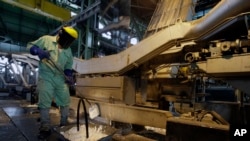Electrical workers in Iran staged a protest Saturday seeking better working conditions and wages, according to Iranian media covering the so-called "yellow hats" protest in front of the National Employment Organization building in Tehran and in cities across the country.
As reported by the ILNA news agency, the demonstrators also expressed discontent about the delayed implementation of the job classification plan. Following the protests, the participants urged the approval and execution of the plan, asserting it has faced continual delays since 2020.
According to the demonstrators, the failure to approve this plan has left approximately 9,000 employees of the Energy Ministry and regional power departments around the nation in a state of uncertainty.
The lack of action on the plan means wages for electrical workers are on par with that of workers with a middle school diploma versus someone who holds a bachelor's degree or higher.
Resentment nationwide reportedly has been rising from the lack of action regarding the job classification plan and has grown into significant labor-related issues, including the December 11 protest by workers at Isfahan Steel Company upset with their wages and who demonstrated and staged a strike on two days earlier in December.
On November 26, Ahvaz Rolling and Pipe Mills Company employees gathered to protest the non-implementation of the job classification plan and voiced concerns about what they say are inadequate wages and benefits.
As an individual's job experience grows, their job group advances, signifying that they should be entitled to a higher percentage of wages than a lesser experienced worker.
In recent years, there has been an increase in labor protests across various regions of Iran, involving strikes, assemblies, and marches. In response, the government has sought to quell these protests through heightened security and judicial measures, though with limited success.
Some economists, such as Masoud Nili, Davood Souri, and Zahra Kaviani, have all scrutinized the financial management by the Islamic Republic over the last four decades. They attribute the increased protests to the rise in the number of people living below the poverty line in Iran.
Another economist, Farshad Momeni, cites "official data" to assert that nearly one in three Iranians is classified as "absolutely poor." Notably, within less than three years, the number of impoverished individuals in Iran has doubled — a phenomenon unprecedented in the last century in Iran.
In an interview with VOA, economist Jamshid Asadi forecasts the budget plan for 2024 will result in higher inflation in Iran and a surge in the poverty rate.






